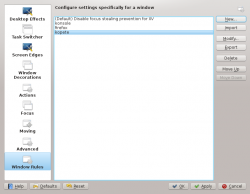KWin Rules: Difference between revisions
No edit summary |
|||
| Line 1: | Line 1: | ||
==Overview== | ==Overview== | ||
'''KWin''' allows the end-user to define rules to alter the behavior of applications. | '''KWin''' allows the end-user to define rules to alter the behavior of applications. | ||
<!--T:73--> | |||
{{Tip|Plasmoids, Workspaces can also be affected.}} | |||
For example, when an application is started, it can be forced to always run on ''Virtual Desktop #2.'' Or a defect in an application can be worked-around by using a rule to, say, always force the window on top of all others. | For example, when an application is started, it can be forced to always run on ''Virtual Desktop #2.'' Or a defect in an application can be worked-around by using a rule to, say, always force the window on top of all others. | ||
| Line 17: | Line 21: | ||
* <menuchoice>Configure Desktop -> Window Behavior -> Window Rules</menuchoice> | * <menuchoice>Configure Desktop -> Window Behavior -> Window Rules</menuchoice> | ||
==Editor Anatomy== | |||
The editor is comprised of four tabs: | |||
# <menuchoice>Window matching</menuchoice> | |||
# <menuchoice>Size & Position</menuchoice> | |||
# <menuchoice>Arrangement & Access</menuchoice> | |||
# <menuchoice>Appearance & Fixes</menuchoice> | |||
==Examples== | ==Examples== | ||
Revision as of 22:27, 23 November 2011
Overview
KWin allows the end-user to define rules to alter the behavior of applications.
For example, when an application is started, it can be forced to always run on Virtual Desktop #2. Or a defect in an application can be worked-around by using a rule to, say, always force the window on top of all others.
This page will define the different settings and the attributes. For the impatient folks, working examples will be listed. Whenever possible, screen shots will be used to show example settings.
KWin Rule Editor

Invoking the Editor
There are several ways one can invoke the Rules editor. Below are a couple:
- Right-click on the title-bar of any window, choosing and in the Configure window, selecting or
Editor Anatomy
The editor is comprised of four tabs:
Examples
Force an Application on a Desktop
Force an Application on all Desktops
Suppress Application showing on Pager
Good for knotes

